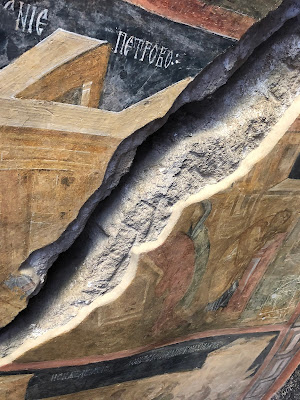We visited two different monasteries built within rocky cliffs.
The first were the rock monasteries of Ivanovo, Bulgaria. These were created in the 13th century. There are numerous "rooms" carved out of the limestone cliffs. Some were meant to be chapels. Others were sleeping chambers.
The caves are over 32 meters from the valley floor. Luckily a trail has been constructed for the ascent. It is much easier to negotiate than the stairs we took going back down!
Here is the view from the cave looking down!
We ducked into a narrow opening.
I was astonished by the frescoes painted on the walls and ceilings so many centuries ago.
The frescoes depict many of the stories of the Bible.
A "calendar" was carved into the floor. Our guide explained that a rock was put in one of the holes, and moved to an adjacent hole each month to keep track of time.
A crack has appear in the ceiling. It cuts through some of the frescoes.
The crack is being monitored by a university. Plastic tapes were adhered to both sides of the crack in different locations. If the crack were to widen, the tape would be torn.
We took a short ride to the second monastery. This one is still in operation today.
There are a number of small chapels tucked up high above the parking area.
The stairs were narrow and steep. But once we got to the top, we saw interesting chapels.
There is a variety of art in the different chapels.
I loved this carving. The camera view makes it look like the Saint is wearing aviation goggles! In person, it looks much different.
In each of the rooms you could see tiny pieces of paper and coins left by people seeking special prayers.
I was surprised that the bathroom has not been updated with a more modern toilet.
























































